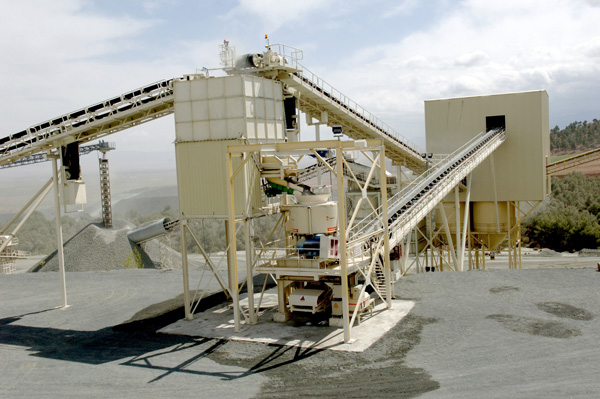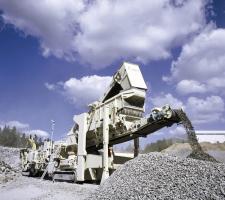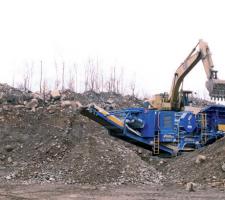
Call for new crushing equipment is almost as high as the demand for higher quality aggregates from customers. Claire Symes reports
Europe's crushing and screening sector has been valued at around €2billion annually and is growing fast. "The crushing sector is growing at roughly the same rate as GDP and in some markets in Europe, it is increasing at a higher rate than that," said
According to
"The sales growth for new equipment is being driven by the high aggregate prices in Europe, coupled with high demand for construction materials," explained Beattie. "Customers are investing in new equipment not just to meet the high demand but also to meet the call for higher quality aggregates." This rise is crushing equipment sales is being partly led by increases in mobile sales. "Five years ago around 40% of crusher sales were mobile, now there is a 50/50 split but in the next five years we expect mobile units to account for 55% of machines sold," said Beattie. The split between mobile and fixed units does vary from country to country around Europe due to cultural differences. Eastern European operations favour fixed plants with a 55% share of the market but if investing in mobile units it tends to be wheeled rather than tracked machines. Western Europe has a slight bias towards mobile machines with the majority being tracked.
Outsourcing
The need for flexibility is driving the trend towards mobile in many areas as outsourcing of crushing capabilities increases - in some cases this means quarry operators are looking to the manufacturers to provide maintenance services rather than carry them out in-house but in others the quarries are looking to contractors to take care of all their crushing needs.
"At the moment quarry operators are looking to closely control the financial side of the business by keeping both costs and assets low," said Santos. "This is creating two types of aggregate producers in Europe.
"The first is the quarry operator that undertakes all the work in-house and has a long term view of the operation with the main asset being the quarry. Their focus is making best use of the reserves available to them, so while they want efficient crushing the emphasis is on quality.
"The second type is the contractor that wants to get into and out of the quarry as quickly as possible and their main asset is the equipment. Contractors want equipment that is not only quick and easy to transport between sites but can also give them high production rates." According to
Maintenance
Many companies operating crushing equipment are now turning to the manufacturers for maintenance services, whereas a decade or so ago this would have been carried out by a team of in-house engineers. This growth sector is being driven partly by the increase in advanced electronics on crushing equipment but also through the quarry operators' needs to control costs and have high machine availability.
"Developments over the last few years have helped to increases the length of time between services," said Svensson. "Remote monitoring has also started to improve the service manufacturers can offer and this will continue to develop. We are already able to log operational data from the crusher and we are now getting to the stage of being able to use this to check for optimal performance. Any changing of the settings still needs to be carried out on site, so complete remote operation is not possible but current technology is already improving efficiency."
Crushing innovation
Developments in crushing technology have improved production capabilities and mean that mobile jaw, impact and cone crushers can now offer volumes to compete with some fixed plants. One industry expert said that over the next few years the market is likely to see development of vertical shaft impact crushers in mobile units. "Customers are demanding to have the whole range of crushing options available in a mobile machine to give them complete flexibility to choose between mobile and fixed plants," he said. In fact Metso has launched its first tracked VSI unit at
According to Santos, the actual function of crushers is unlikely to change significantly in the near future. "Innovation in the next decade is more likely to be fine tuning of existing technology," he said. "Use of microwave or laser technology for breaking rock is a very long way in the future." Instead Santos believes that development will focus on making machine safer and easier to use. "There is still a high potential to be injured when working with the hydraulics and settings on a crusher if correct procedures are not carried out," he said. "Over the next five to 10 years there will be better protection accessories available. Greater automation is also likely, which will remove the need for interaction with the machines, further adding to the safety aspects." Environmental issues are also something manufacturers are looking at. Many new static plants are now enclosed to reduce sound and dust emissions and attention is now turning to improving the environmental performance of mobile machines.
"There is a possibility that in 10 years time, tracked machines may not be diesel powered anymore and may turn to electrical operation," said Santos. "Nonetheless, this type of development is very dependent on legislative drivers."
One thing that is almost guaranteed is that most manufacturers are looking to further maximise production rates. "Over the last few years we have managed to increase the efficiency of crushers, while keeping them in the same envelope," said Svensson. "Crushing equipment is more productive today than in the past and that is a trend that is likely to continue in the future."
Adding capacity
A New York quarry operator thought its existing crushing plants were portable until its recent investment in a new mobile plant opened up new opportunities and increased capacity.
With two gravel pits, a hard rock quarry and processing of blasted rock from construction sites, US-based J E Sheehan Contracting is well used to the crushing and screening process. But the company had always considered its plants at the gravel sites to be 'mobile' despite the time and cost involved in relocating the equipment for contract work.
Recent investment in a new mobile jaw crusher from
Sheehan's Catamount Ridge Quarry near Wintrhop opened in 1995 to extract the dolomitic limestone. The site has a stationary crushing and screening plant, which was used to process more than 1million tonnes of aggregates for remediation of the Alcoa plant.
But it is at Sheehan's Gonyo and Gadway gravel pits where the operations are more mobile. Both sites have a portable jaw crusher for primary crushing and a cone unit for secondary processing, along with a selection of screens.
The set up at both gravel pits regularly produces around 280tonnes per hour of 355 to 38mm material but the problems with production came when the plants needed to be moved to a construction site to carry out contract work. Many of the contract projects involve volumes of around 7500m3 and Sheehan could not compete on cost with some of the small companies in the region because its 'portable' crushers were not truly mobile.
Moving costs
According to Sheehan gravel pit supervisor Russ Thompson, moving the older plants can take up to a week and cost over €3000 and the same again to return them to the quarry. The cost is not only high in financial terms but also in that of lost production. "Based on a 10 hour day producing 280tonnes per hour, that's around 2,800tonnes of crushed rock that could have been produced while the plants stand idle during moving," he said.
With the growth of contract crushing work in the region and the need to supplement capacity at the gravel pits, Sheehan began to look at more mobile units. The company's solution was investment in a Fintec 1107 mobile jaw crusher which could be moved to another site and be ready for use in less than a day.
The 50tonne Fintec unit is built around a Sandvik CJ211 jaw crusher with a nominal feed opening of 1.1 to 0.71m and a 7m3 hopper. It has a primary jaw toggle with a fully adjustable wedge design that is hydraulically powered and, according to Thompson, is ideal for Sheehan's hard rock crushing applications.
"Most of the custom crushing work we do requires only a primary jaw and if we have need for a cone crusher plant on site, we can rent. It would not take any more time to move a Fintec cone crusher plant than the jaw crusher plant. If there were enough projects requiring the use of a secondary plant, we can always buy a cone crusher plant just as we bought the jaw crusher plant. So, we have the option to rent or buy from Capital," said Thompson.

















